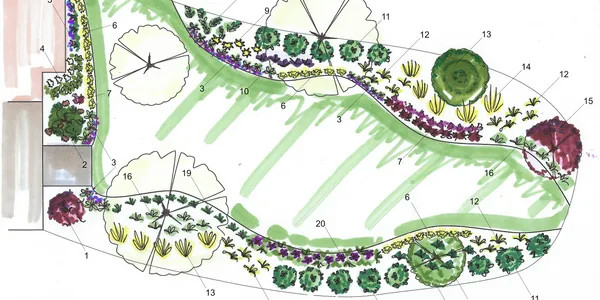THE REDESIGN OF A LANDSCAPE AND/OR GARDENS

In nature, plants grow in layers: tall trees form a canopy, mid-sized shrubs fill the space below, and smaller groundcovers spread at the base. In a landscape, you can mimic this to create depth and balance. A well-designed garden layers plant by height, texture, and color with time in mind. You want the landscape to evolve gracefully, not overwhelm itself.
THINK OF THE LAYERS IN YOUR GARDEN IN THREE MAIN CATEGORIES?
- Tall layer (backdrop): Trees, large shrubs, or tall grasses
- Middle layer (focal point): Roses, Dwarf shrubs, Hydrangeas and Key Statement Plants
- Front layer (border): Perennials, Low-growing plants, groundcovers, and edgers
PLANTING WITHOUT A LONG-TERM VISION?
When I design gardens, I think 3, 5, even 10 years ahead. A significant ornamental tree should frame the foundation entry, not block the window by year three.
It is a common scenario for a newly planted garden to outgrow its initial design, transforming a cozy space into a crowded jungle. This often happens because people underestimate the mature size of the plants they select. Additionally, when you place consistent irrigation on these plants and keep up the consistent watering the plants grow much faster.
Proper planning involves careful consideration of a plant's eventual height and spread, ensuring sufficient room for growth without overcrowding. Regular maintenance through pruning and dividing
perennials can also help manage the garden's size and maintain its aesthetic appeal.
You want the landscape to evolve gracefully, not overwhelm itself.
In March we would like to come due to some dormant pruning to the landscape. This is an ideal time for more significant pruning because the structure of the plant is clearly visible and the plant experiences less stress. The goals are to improve plant health and structure by removing dead or diseased branches, correcting growth problems, and preparing the plant for new growth in the spring.
IDENTIFY KEY PLANTS:
Choose what plants are your favorite and repeat them throughout the garden itself. Will these favorite plants, I will find the perfect spot for them to offer rhythm in your new garden. And bonus points if your plants have ecological benefits! Food for the birds, larva for the butterflies, nectar for the bees?
REPEATING WITH PURPOSE: Your garden is small; you may have to make some hard calls on what to remove to be able to allow the garden some breathing room. Ask yourself, is there anything here that struggles or looks bad? I keep a garden journal or bloom calendar which is my bible with decisions. I understand you bought plants because you liked them at the garden center. You brought them home,
planted them and are they still winners?
WHY TEXTURE MATTERS IN GARDEN DESIGN?
Creating a visually engaging garden is not just about color. Texture plays a key role in adding depth, contrast, and structure to your garden and landscape. By combining plants with a variety of diverse textures, you can enhance your garden’s aesthetic appeal year-round.
Plants, including leaves, stems, flowers, and bark. Textures can be categorized as:
- Fine Texture – Delicate, feathery foliage (e.g., ferns, grasses, thread leaf plants).
- Medium Texture – Rounded or slightly lobed leaves (e.g., hostas, hydrangeas).
- Coarse Texture – Large, bold leaves (e.g., rhubarb, ligularia).
Using a mix of textures we can create a layered effect, provide contrast and prevent your garden from looking monotonous. Monochromatic gardens are useful with a single color to create a visually appealing display. Many people are often reluctant to try their hand at creating a monochromatic
garden for fear of it looking a tad uninspiring.!
HOW CAN I USE TEXTURE TO MAKE YOUR GARDEN LOOK BIGGER?
To make a garden look bigger, combine fine-textured plants with coarse-textured ones to create depth, using fine-textured plants like ferns or grasses to make the space feel airier and larger. Strategically mix
plant textures, layer greenery along borders, and use hardscaping elements like curved paths using gravel, stepping stones or different mulches to break up the space and add dimension. These pathways have a purpose to lead you through and around your garden.
GARDEN DESIGN:
It is true that garden design often relies on "trusting your eye" and adjusting during the planting process. Peter Atkins recommended a flexible approach, viewing the design as a living blueprint rather than a rigid plan on paper that few can understand what the garden will look like in reality. We do use 2D and 3D design software to share the mood board vision for the garden. This is typically a slice of the garden to share the direction of the garden.
It is true that garden design often relies on instinct and hands-on rearrangement, a process known as "trusting your eye". Many experienced gardeners find that while paper planning is helpful, the actual
arrangement of plants evolve during the physical process of working in the garden. Gardening is often a balance between structured planning and intuitive judgment, celebrating the organic nature of working with living elements.
Written by Peter Atkins, November 14, 2025